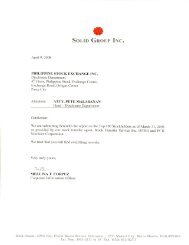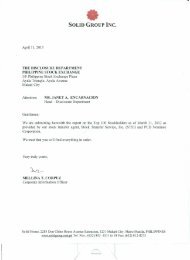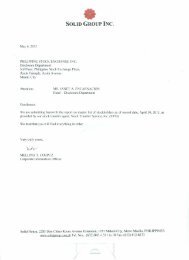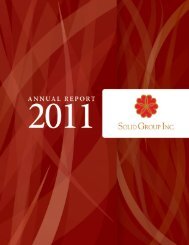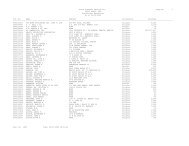SEC Form 17-A: Annual Report - the solid group inc website
SEC Form 17-A: Annual Report - the solid group inc website
SEC Form 17-A: Annual Report - the solid group inc website
You also want an ePaper? Increase the reach of your titles
YUMPU automatically turns print PDFs into web optimized ePapers that Google loves.
- 16 -<br />
2.8 O<strong>the</strong>r Assets<br />
O<strong>the</strong>r assets pertain to o<strong>the</strong>r resources controlled by <strong>the</strong> Company as a result of past<br />
events. They are recognized in <strong>the</strong> financial statements when it is probable that <strong>the</strong><br />
future economic benefits will flow to <strong>the</strong> entity and <strong>the</strong> asset has a cost or value that can<br />
be measured reliably.<br />
O<strong>the</strong>r recognized assets of similar nature, where future economic benefits are expected<br />
to flow to <strong>the</strong> Company beyond one year after <strong>the</strong> end of <strong>the</strong> reporting period<br />
(or in <strong>the</strong> normal operating cycle of <strong>the</strong> business, if longer), are classified as non-current<br />
assets.<br />
2.9 Property, Plant and Equipment<br />
Property, plant and equipment, except land, are carried at acquisition cost or<br />
construction cost less subsequent depreciation, amortization and any impairment losses.<br />
Land held for use in production or administration is stated at cost less any impairment<br />
losses.<br />
The cost of an asset comprises its purchase price and directly attributable costs of<br />
bringing <strong>the</strong> asset to working condition for its intended use. Expenditures for<br />
additions, major improvements and renewals are capitalized; expenditures for repairs<br />
and maintenance are charged to expense as <strong>inc</strong>urred.<br />
Depreciation is computed on <strong>the</strong> straight-line basis over <strong>the</strong> estimated useful lives of<br />
<strong>the</strong> assets as follows:<br />
Buildings and improvements<br />
Test, communication and o<strong>the</strong>r equipment<br />
Cable system equipment<br />
Machinery and equipment<br />
Transportation equipment<br />
Computer system<br />
Furniture, fixtures and office equipment<br />
Tools and equipment<br />
10 to 25 years<br />
5 to 20 years<br />
2 to 20 years<br />
5 to 10 years<br />
5 years<br />
2 to 5 years<br />
2 to 5 years<br />
2 to 3 years<br />
Construction in progress represents properties under construction and is stated at cost.<br />
This <strong>inc</strong>ludes cost of construction, applicable borrowing cost (see Note 2.20) and o<strong>the</strong>r<br />
direct costs. The account is not depreciated until such time that <strong>the</strong> assets are<br />
completed and available for use.<br />
Leasehold improvements are amortized over <strong>the</strong> estimated useful lives of <strong>the</strong> assets<br />
from 2 to 15 years or <strong>the</strong> term of <strong>the</strong> lease, whichever is shorter.<br />
Fully depreciated and amortized assets are retained in <strong>the</strong> accounts until <strong>the</strong>y are no<br />
longer in use and no fur<strong>the</strong>r charge for depreciation and amortization is made in respect<br />
of those assets.<br />
An asset’s carrying amount is written down immediately to its recoverable amount if <strong>the</strong><br />
asset’s carrying amount is greater than its estimated recoverable amount (see Note 2.18).<br />
The residual values and estimated useful lives of property and equipment are reviewed,<br />
and adjusted if appropriate, at <strong>the</strong> end of each reporting period.



